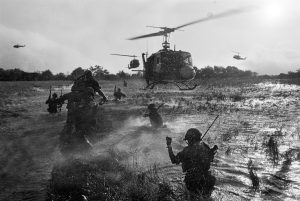The Vietnam War:
Many historical examples help us understand the changes in warfare. Since Fourth Generation Warfare describes the only type of war the United States has ever lost, it is important to analyze what happened in Vietnam to understand this new type of war better. Even though the United States was both technologically and militarily advanced than Vietnam, the U.S. still lost because Vietnam “broke the rules” (Elias, “Four Generations”). The war was not a contest between militaries but rather a contest of political will. Vietnam had far less superior technology in comparison to the United States’ efficient and advanced weapons. The Vietnamese improvised explosive devices, creating weapons on the battlefield and attacking Americans with their previously used weapons. The Vietnamese buried sticks in the ground and covered them with human feces to maximize U.S. soldier infection. They also created elaborate underground tunnels where they could hide (Elias, “Four Generations”). This ingenuity catalyzed a new generation of war that directly infiltrated the opponents’ will to continue fighting. The Vietnamese knew America did not have the same will power as they did and used that to their advantage, eventually securing their ultimate victory. “They [Vietnamese] dictated the tempo, timing, number, of engagements, terms of engagement areas of operation, and fixed outcome” (Hammes 73). The United States saw the Vietnam war as a “limited war,” not being fully committed to the war, as they were too certain that their military superiority was enough to make them victorious.

A major part of Fourth Generation Warfare is that it is longer than conventional war, it is measured in decades rather than months or years like previous generations of war (Hammes 3). Therefore, Vietnam prepared for a “long term war,” showing their willingness and willpower during the war (Hammes 63). Hammes states, “We were fighting an entirely different war than the Vietnamese” (Hammes 73). The United States did not adapt to these new war tactics like the Vietnamese had, eventually costing them the war. A key part of Fourth Generation Warfare is using political strategies to defeat the enemy. Unlike previous wars, political and psychological strategies are more important than just defeating their adversary’s military. “Aware of his military and economic inferiority, Ho sought to use international political maneuvering in conjunction with guerrilla warfare to bring about this [regressing to phase II] change” (Hammes 64). As Mao discussed, guerrilla’s have time and often go back to phases one and two if they cannot win. Therefore, the Vietnam war is a great historical example of how the United States lost to Fourth Generation Warfare and how it must use lessons learned in Vietnam to maintain power.
World War II:

In the bombings of Hiroshima and Nagasaki, the United States demonstrated its power to hurt through indirect use of force. The United States was able to use compellence because Japan did not also have nuclear weapons. This set a precedent for the international security community following World War II: threatening the use of force by sending a message to the adversary and having the capability to follow through demonstrates credibility and willingness on an international level. Schelling states, “The bomb that hit Hiroshima was a threat aimed at all of Japan. The political target of the bomb was not the dead of Hiroshima or the factories they worked in, but the survivors in Tokyo”(Schelling 17).
He makes this argument because major military decision makers were in Tokyo. Therefore, sending this message to them presented the United States as having the willingness and capability to deploy nuclear weapons. Schelling then claims that “the power to hurt, though it can usually accomplish nothing directly, is potentially more versatile than a straightforward capacity for forcible accomplishment” (Schelling 8). This suggests to the international community that the use of indirect force to send a message to the adversary has demonstrated its success in Japan to end the war, influencing states such as the United States and U.S.S.R to build up their arsenals in order to avoid a third world war.
Nuclear Deterrence:
Mutually Assured Destruction between the United States and Russia throughout the Cold War emphasized nuclear deterrence to avoid a third world war. Full-scale use of nuclear weapons between two states would cause total annihilation of both nations, so this type of nuclear force is best when held in reserve (Elias, “Nuclear Deterrence”). The United States and Russia have held each other hostage, knowing that whoever shoots first, will always die second (Elias, “Nuclear Deterrence”). In order to stabilize nuclear deterrence and demonstrate credibility, states need the capability and willingness to follow through on the enemy. As a result, countries should not strike first. Striking first entails a country has the ability to take out the opponent’s retaliatory second strike capability, something that no state is capable of (Elias, “Nuclear Deterrence”).

Thus, focusing on strengthening second strike capabilities allows for dispersing of weapons and command and control, making it more difficult for the enemy to locate nuclear facilities. Additionally, states have to exemplify their credibility by tying their hands and showing commitment and willingness to their stated objectives (Schelling 2). States illustrate their willingness when they have commands in place that will be executed automatically if the enemy initiates a nuclear strike (Elias, “Nuclear Deterrence”). Therefore, nuclear deterrence by means of mutually assured destruction between states protects millions of civilians and prevents massive global conflict.
